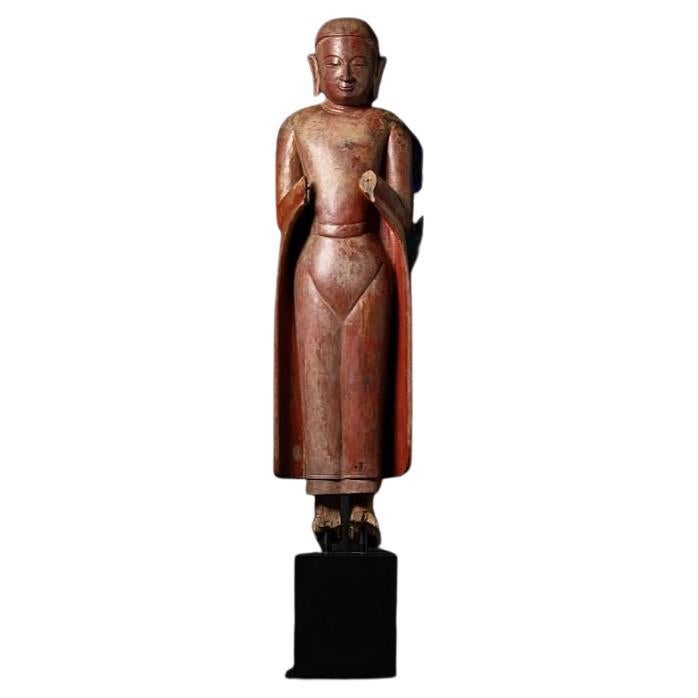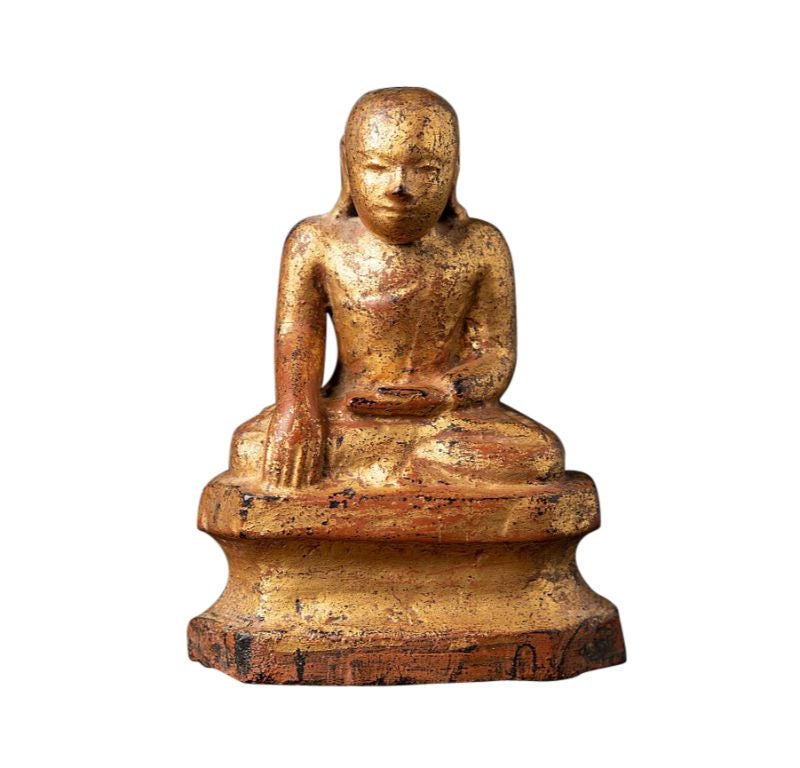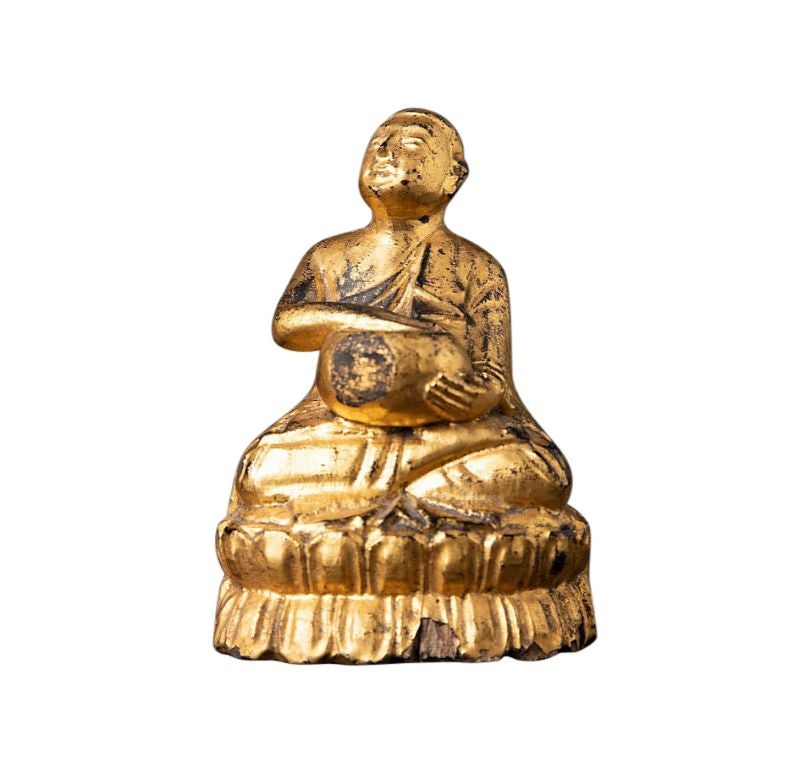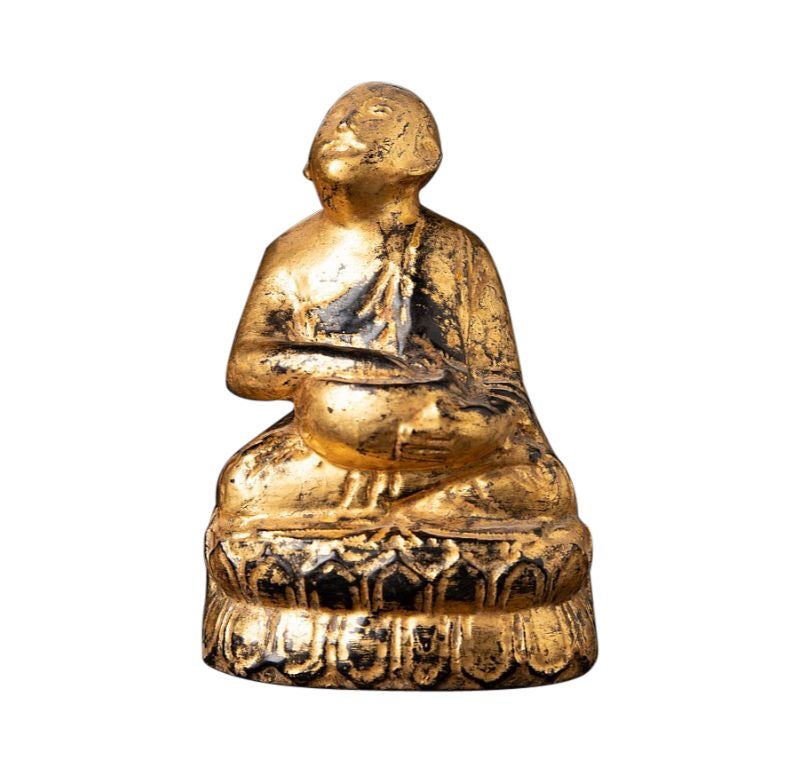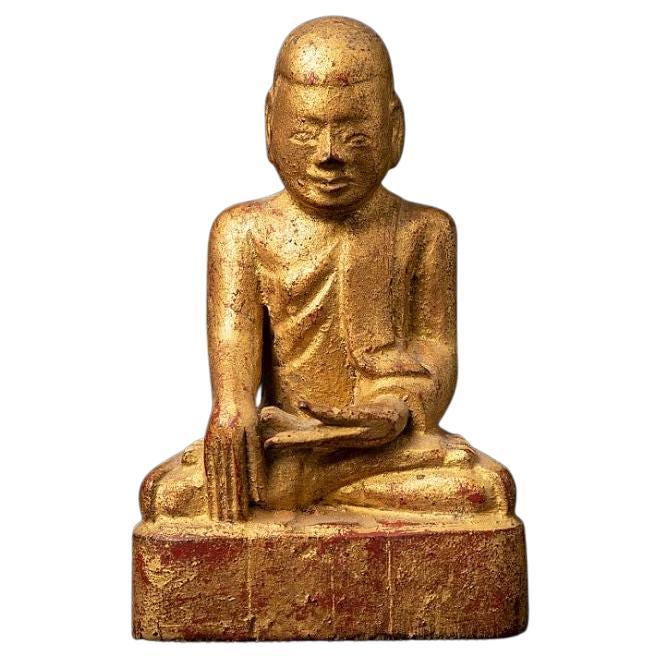Items Similar to Large 17th Century Wooden Burmese Monk Statue from Burma
Video Loading
Want more images or videos?
Request additional images or videos from the seller
1 of 22
Large 17th Century Wooden Burmese Monk Statue from Burma
About the Item
Material: wood
180 cm high
43 cm wide and 34,5 cm deep
With traces of 24 krt. gilding
Ava style
Namaskara mudra
Originating from Burma
17th century.
- Dimensions:Height: 70.87 in (180 cm)Width: 16.93 in (43 cm)Depth: 13.59 in (34.5 cm)
- Materials and Techniques:
- Place of Origin:
- Period:
- Date of Manufacture:17th Century
- Condition:Wear consistent with age and use.
- Seller Location:DEVENTER, NL
- Reference Number:
About the Seller
5.0
Gold Seller
These expertly vetted sellers are highly rated and consistently exceed customer expectations.
Established in 1997
1stDibs seller since 2022
20 sales on 1stDibs
Typical response time: 9 hours
- ShippingRetrieving quote...Ships From: DEVENTER, Netherlands
- Return PolicyA return for this item may be initiated within 14 days of delivery.
More From This SellerView All
- Large 17th Century Wooden Burmese Monk Statue from BurmaLocated in DEVENTER, NLMaterial: wood Measures: 187 cm high 39,5 cm wide and 34,5 cm deep With traces of 24 krt. gilding Ava style Namaskara mudra Originating from Burma 17th century.Category
Antique 17th Century Burmese Sculptures and Carvings
MaterialsWood
- Antique Wooden Burmese Monk Statue from, BurmaLocated in DEVENTER, NLMaterial: wood. Measures: 13 cm high. 8 cm wide and 4, 5 cm deep. Weight: 0.098 kgs. Gilded with 24 krt. gold. Bhumisparsha mudra. Originating from Burma. 19th Century.Category
Antique 19th Century Burmese Sculptures and Carvings
MaterialsWood
- Antique Wooden Burmese Monk Statue from BurmaLocated in DEVENTER, NLMaterial: wood 15 cm high 11,4 cm wide and 6,5 cm deep Weight: 0.192 kgs Gilded with 24 krt. gold Bhumisparsha mudra Originating from Burma 18th century.Category
Antique 18th Century Burmese Sculptures and Carvings
MaterialsWood
- Antique Wooden Burmese Monk Statue from BurmaLocated in DEVENTER, NLMaterial: wood 18,5 cm high 12,7 cm wide and 10,3 cm deep Weight: 0.538 kgs Gilded with 24 krt. gold Originating from Burma 19th century.Category
Antique 19th Century Burmese Sculptures and Carvings
MaterialsWood
- Antique Wooden Burmese Monk Statue from BurmaLocated in DEVENTER, NLMaterial: wood 13,3 cm high 9,6 cm wide and 8,1 cm deep Weight: 0.15 kgs Gilded with 24 krt. gold Originating from Burma 19th century It seems that at the backside of the ped...Category
Antique 19th Century Burmese Sculptures and Carvings
MaterialsWood
- Antique Wooden Burmese Monk Statue from BurmaLocated in DEVENTER, NLMaterial: wood 12,9 cm high 8,2 cm wide and 4,5 cm deep Weight: 0.101 kgs Gilded with 24 krt. gold Bhumisparsha mudra Originating from Burma 19th centuryCategory
Antique 19th Century Burmese Sculptures and Carvings
MaterialsWood
You May Also Like
- Indian Hindu Bronze Sculpture of Khandoba, 17th / 18th CenturyLocated in Vero Beach, FLIndian Hindu bronze sculpture of Khandoba 17th/18th century The bronze figure on horseback represents the most popular Hindu deity Khandoba, an avatar...Category
Antique 18th Century Indian Other Sculptures and Carvings
MaterialsBronze
- Large 19th century Chinese Carved Wooden Tea CaddyLocated in Atlanta, GABeautifully carved Qing dynasty tea caddy from Elmwood (yumu), with floral motifs and finished with an oxblood color lacquer. The large size is very usual and was used in a large family compound. The tea caddy is designed to hold and keep warm, large tea pot filled with tea. The tea pot’s spout comes out the front opening for pouring. The horizontal bar used as the container’s handle has a pivoting lock when open, the handle bar can be removed and closing of the pivoting lock, the handle is secure for use. The wooden tea caddy...Category
Antique Late 19th Century Chinese Sculptures and Carvings
MaterialsElm
- Large Burmese Bronze Medicine Buddha, Pagan Style, Late 19th CenturyLocated in Austin, TXA large and magnificent cast bronze image of the Medicine Buddha, Bhaisajyaguru, rendered in the Burmese Pagan style, and most likely based on a period example that was either damaged or lost, 19th century, Burma or Thailand. He can be identified as the Medicine Buddha by the hand that rests in his lap, with his middle finger touching the thumb. A medicine pot or fruit stem would originally have been placed in his upturned palm. The face of this Buddha has been sculpted masterfully. He has a beautiful heart shaped face topped by hair neatly arranged in the typical "snail shell curls", and surmounted by a high ushnisha. Long, pendulous earlobes frame his face, a symbol of his princely past. He gazes serenely outwards from heavily lidded, downcast eyes, a content smile upon his full, lush lips. The Buddha is portrayed seated in vajrasana (full lotus position), his elegant hands displayed in varada mudra, the gesture of granting favors and fulfilling wishes. Long, exquisite fingers extended, the thumb and middle finger touching in a gesture of compassion. He is clothed in a simple kasaya wrapped around his body and over one shoulder, leaving the shoulder and part of his chest bare. The diaphanous garment clings to his body, outlining his well proportioned and graceful, almost sensuous, form. The excess material pooled in neat pleats in front of him. A sash thrown over his shoulder. He sits upon a double lotus base upon a raised platform. The platform features two kneeling attendants, usually interpreted as the monks Ananda and Kasyapa. Between them is a circular disc representing the Wheel of Dharma. Contained in the disk is a flower with eight petals, symbolizing the eightfold path, one of the principle teachings of the Buddha. The sides and back of the platform featuring a series of singha, or lions, representative of the Buddha's royal past. An applied lacquer patina covers the entirety of the image. Large deposits of ash (from incense) are present between the curls of the hair, as well as some the other crevices, indicating this image was the subject of worship for many years. Bhaisajyaguru, also called the Medicine Buddha, or Buddha of Healing, is a revered figure in the Buddhist pantheon as a master able to cure suffering, both physical and spiritual, through his teachings. The Pagan Empire ruled most of present day Burma (Myanmar) from 849 to 1297. The capital, Bagan, served as a both the center of government and religion, where Buddhism reigned supreme. Bagan was also at a crossroads of the Buddhist world, with influence from India, Nepal, Tibet, China, and even Indonesia shaping their culture. As such, Pagan Buddha...Category
Antique Late 19th Century Burmese Sculptures and Carvings
MaterialsBronze
- 20th Century Sculpted Wooden Traditional Mask from Timor Island, IndonesiaLocated in London, GBTimor Island sculpted wooden traditional mask (circa 1960s-1970s) on contemporary stand. This is a traditional mask of a figure with male facial features and two holes as eyes and another for the mouth. The island of Timor gave rise to a distinctive practice of creating traditional masks whose precise origins and significance remain uncertain. Portraying both male and female ancestors, they were held by men during dances and other ceremonies, including celebrations of victory in war. Carved sculptures and masks are specific to rural villages. Here the practice of animism, or nature-worship, is incorporated with the carving of ancestral statues and masks, which have a ritualistic function. Some occasions that call for these ceremonies may include asking for successful crop planting, for prosperity, for good...Category
Mid-20th Century Indonesian Tribal Sculptures and Carvings
MaterialsWood
- Large Early 19th Century Gilded Carved Wooden Vietnamese BuddhaLocated in Atlanta, GAA highly decorative early 19th century Vietnamese carved wooden and polychrome painted Buddha with traces of original gilding, creating a beautiful p...Category
Antique Early 19th Century Vietnamese Sculptures and Carvings
MaterialsWood
- Large 18th Century Chinese Carved Wooden Altar God of Guan YuLocated in Atlanta, GAThis Ching Dynasty carved polychrome seated altar god is a representation of Guan Yu. Guan Yu was a Chinese military general serving under the warlord Liu ...Category
Antique Late 18th Century Chinese Sculptures and Carvings
MaterialsGold Leaf
Recently Viewed
View AllMore Ways To Browse
Trace Antique
180 Cm
Large Wooden Sculpture
Large Antique Statue
Large Antique Statues
17th Wood Sculpture
Sculpture Wood 17th Century
Monk Sculpture
Large Asian Wood Carving
Wood Monk
17th Century Wood Carving
Large Monk
Large Wood Statue
Large Asian Statues
17th Century Wooden Sculpture
Wood Monk Sculpture
Burmese Monk
Burma Monk
